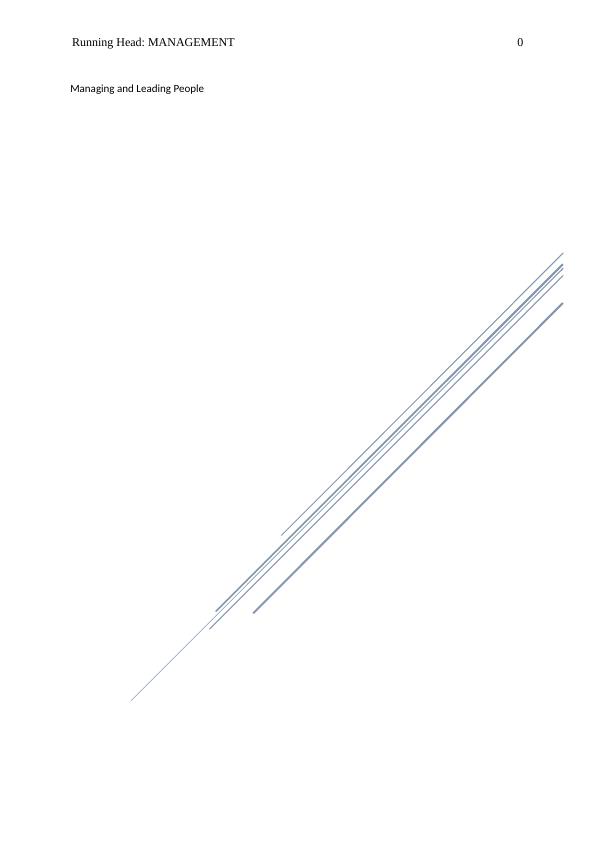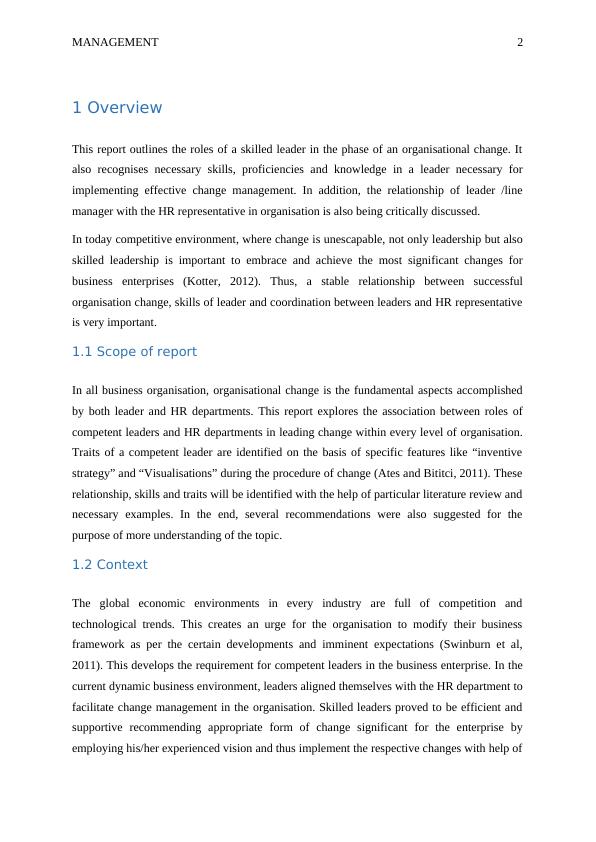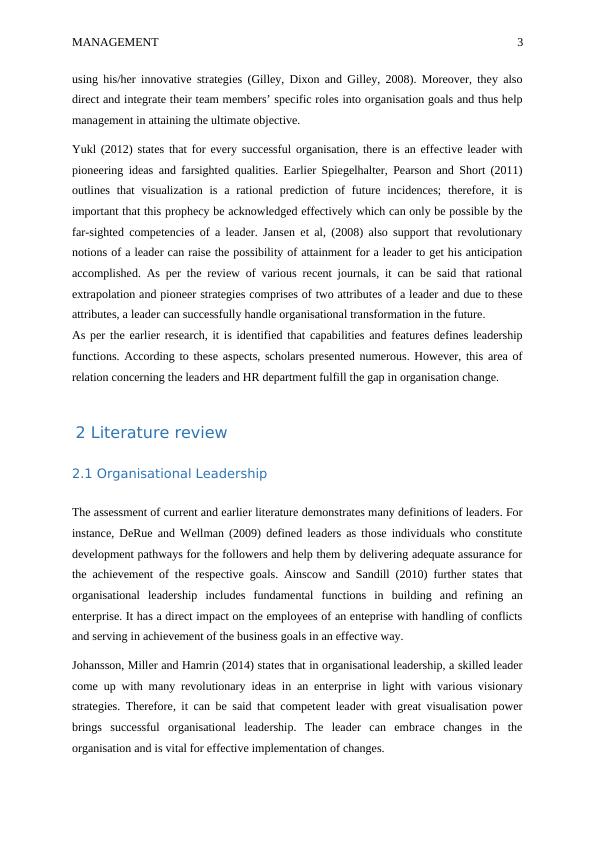Managing and Leading People
Added on 2023-04-21
18 Pages5566 Words143 Views
Running Head: MANAGEMENT 0
Managing and Leading People
Managing and Leading People

MANAGEMENT 1
Table of Contents
1 Overview.................................................................................................................................2
1.1 Scope of report.................................................................................................................2
1.2 Context.............................................................................................................................2
2 Literature review.....................................................................................................................3
2.1 Organisational Leadership...............................................................................................3
2.1.1 Visionary Organizational Leadership.......................................................................4
2.1.2 Innovative outlook of leadership...............................................................................4
2.2 Leadership Theories.........................................................................................................5
2.2.1 Contingency Theory..................................................................................................5
2.2.2 Path-Goal Theory......................................................................................................6
2.2.3 Transformational Theory..........................................................................................6
2.3 The significance of Change in Organisations..................................................................6
2.4 Role of Leadership in Organizational Changes...............................................................8
2.5 Apple Case Study example..............................................................................................9
3 Relationship in management of people.................................................................................10
Conclusion................................................................................................................................13
References................................................................................................................................14
Table of Contents
1 Overview.................................................................................................................................2
1.1 Scope of report.................................................................................................................2
1.2 Context.............................................................................................................................2
2 Literature review.....................................................................................................................3
2.1 Organisational Leadership...............................................................................................3
2.1.1 Visionary Organizational Leadership.......................................................................4
2.1.2 Innovative outlook of leadership...............................................................................4
2.2 Leadership Theories.........................................................................................................5
2.2.1 Contingency Theory..................................................................................................5
2.2.2 Path-Goal Theory......................................................................................................6
2.2.3 Transformational Theory..........................................................................................6
2.3 The significance of Change in Organisations..................................................................6
2.4 Role of Leadership in Organizational Changes...............................................................8
2.5 Apple Case Study example..............................................................................................9
3 Relationship in management of people.................................................................................10
Conclusion................................................................................................................................13
References................................................................................................................................14

MANAGEMENT 2
1 Overview
This report outlines the roles of a skilled leader in the phase of an organisational change. It
also recognises necessary skills, proficiencies and knowledge in a leader necessary for
implementing effective change management. In addition, the relationship of leader /line
manager with the HR representative in organisation is also being critically discussed.
In today competitive environment, where change is unescapable, not only leadership but also
skilled leadership is important to embrace and achieve the most significant changes for
business enterprises (Kotter, 2012). Thus, a stable relationship between successful
organisation change, skills of leader and coordination between leaders and HR representative
is very important.
1.1 Scope of report
In all business organisation, organisational change is the fundamental aspects accomplished
by both leader and HR departments. This report explores the association between roles of
competent leaders and HR departments in leading change within every level of organisation.
Traits of a competent leader are identified on the basis of specific features like “inventive
strategy” and “Visualisations” during the procedure of change (Ates and Bititci, 2011). These
relationship, skills and traits will be identified with the help of particular literature review and
necessary examples. In the end, several recommendations were also suggested for the
purpose of more understanding of the topic.
1.2 Context
The global economic environments in every industry are full of competition and
technological trends. This creates an urge for the organisation to modify their business
framework as per the certain developments and imminent expectations (Swinburn et al,
2011). This develops the requirement for competent leaders in the business enterprise. In the
current dynamic business environment, leaders aligned themselves with the HR department to
facilitate change management in the organisation. Skilled leaders proved to be efficient and
supportive recommending appropriate form of change significant for the enterprise by
employing his/her experienced vision and thus implement the respective changes with help of
1 Overview
This report outlines the roles of a skilled leader in the phase of an organisational change. It
also recognises necessary skills, proficiencies and knowledge in a leader necessary for
implementing effective change management. In addition, the relationship of leader /line
manager with the HR representative in organisation is also being critically discussed.
In today competitive environment, where change is unescapable, not only leadership but also
skilled leadership is important to embrace and achieve the most significant changes for
business enterprises (Kotter, 2012). Thus, a stable relationship between successful
organisation change, skills of leader and coordination between leaders and HR representative
is very important.
1.1 Scope of report
In all business organisation, organisational change is the fundamental aspects accomplished
by both leader and HR departments. This report explores the association between roles of
competent leaders and HR departments in leading change within every level of organisation.
Traits of a competent leader are identified on the basis of specific features like “inventive
strategy” and “Visualisations” during the procedure of change (Ates and Bititci, 2011). These
relationship, skills and traits will be identified with the help of particular literature review and
necessary examples. In the end, several recommendations were also suggested for the
purpose of more understanding of the topic.
1.2 Context
The global economic environments in every industry are full of competition and
technological trends. This creates an urge for the organisation to modify their business
framework as per the certain developments and imminent expectations (Swinburn et al,
2011). This develops the requirement for competent leaders in the business enterprise. In the
current dynamic business environment, leaders aligned themselves with the HR department to
facilitate change management in the organisation. Skilled leaders proved to be efficient and
supportive recommending appropriate form of change significant for the enterprise by
employing his/her experienced vision and thus implement the respective changes with help of

MANAGEMENT 3
using his/her innovative strategies (Gilley, Dixon and Gilley, 2008). Moreover, they also
direct and integrate their team members’ specific roles into organisation goals and thus help
management in attaining the ultimate objective.
Yukl (2012) states that for every successful organisation, there is an effective leader with
pioneering ideas and farsighted qualities. Earlier Spiegelhalter, Pearson and Short (2011)
outlines that visualization is a rational prediction of future incidences; therefore, it is
important that this prophecy be acknowledged effectively which can only be possible by the
far-sighted competencies of a leader. Jansen et al, (2008) also support that revolutionary
notions of a leader can raise the possibility of attainment for a leader to get his anticipation
accomplished. As per the review of various recent journals, it can be said that rational
extrapolation and pioneer strategies comprises of two attributes of a leader and due to these
attributes, a leader can successfully handle organisational transformation in the future.
As per the earlier research, it is identified that capabilities and features defines leadership
functions. According to these aspects, scholars presented numerous. However, this area of
relation concerning the leaders and HR department fulfill the gap in organisation change.
2 Literature review
2.1 Organisational Leadership
The assessment of current and earlier literature demonstrates many definitions of leaders. For
instance, DeRue and Wellman (2009) defined leaders as those individuals who constitute
development pathways for the followers and help them by delivering adequate assurance for
the achievement of the respective goals. Ainscow and Sandill (2010) further states that
organisational leadership includes fundamental functions in building and refining an
enterprise. It has a direct impact on the employees of an enteprise with handling of conflicts
and serving in achievement of the business goals in an effective way.
Johansson, Miller and Hamrin (2014) states that in organisational leadership, a skilled leader
come up with many revolutionary ideas in an enterprise in light with various visionary
strategies. Therefore, it can be said that competent leader with great visualisation power
brings successful organisational leadership. The leader can embrace changes in the
organisation and is vital for effective implementation of changes.
using his/her innovative strategies (Gilley, Dixon and Gilley, 2008). Moreover, they also
direct and integrate their team members’ specific roles into organisation goals and thus help
management in attaining the ultimate objective.
Yukl (2012) states that for every successful organisation, there is an effective leader with
pioneering ideas and farsighted qualities. Earlier Spiegelhalter, Pearson and Short (2011)
outlines that visualization is a rational prediction of future incidences; therefore, it is
important that this prophecy be acknowledged effectively which can only be possible by the
far-sighted competencies of a leader. Jansen et al, (2008) also support that revolutionary
notions of a leader can raise the possibility of attainment for a leader to get his anticipation
accomplished. As per the review of various recent journals, it can be said that rational
extrapolation and pioneer strategies comprises of two attributes of a leader and due to these
attributes, a leader can successfully handle organisational transformation in the future.
As per the earlier research, it is identified that capabilities and features defines leadership
functions. According to these aspects, scholars presented numerous. However, this area of
relation concerning the leaders and HR department fulfill the gap in organisation change.
2 Literature review
2.1 Organisational Leadership
The assessment of current and earlier literature demonstrates many definitions of leaders. For
instance, DeRue and Wellman (2009) defined leaders as those individuals who constitute
development pathways for the followers and help them by delivering adequate assurance for
the achievement of the respective goals. Ainscow and Sandill (2010) further states that
organisational leadership includes fundamental functions in building and refining an
enterprise. It has a direct impact on the employees of an enteprise with handling of conflicts
and serving in achievement of the business goals in an effective way.
Johansson, Miller and Hamrin (2014) states that in organisational leadership, a skilled leader
come up with many revolutionary ideas in an enterprise in light with various visionary
strategies. Therefore, it can be said that competent leader with great visualisation power
brings successful organisational leadership. The leader can embrace changes in the
organisation and is vital for effective implementation of changes.

End of preview
Want to access all the pages? Upload your documents or become a member.
Related Documents
Leadership and Management- PepsiCo Foods Mexico (document)lg...
|12
|3244
|55
Organisation Strategies for Improved Performancelg...
|10
|2369
|352
Management and Operationslg...
|10
|448
|495
Differences between Contingency and Trait Theorylg...
|10
|3497
|318
The Developing Manager: Assignmentlg...
|10
|2775
|203
Contingency Theory of Leadership : Assignmentlg...
|21
|7025
|192
